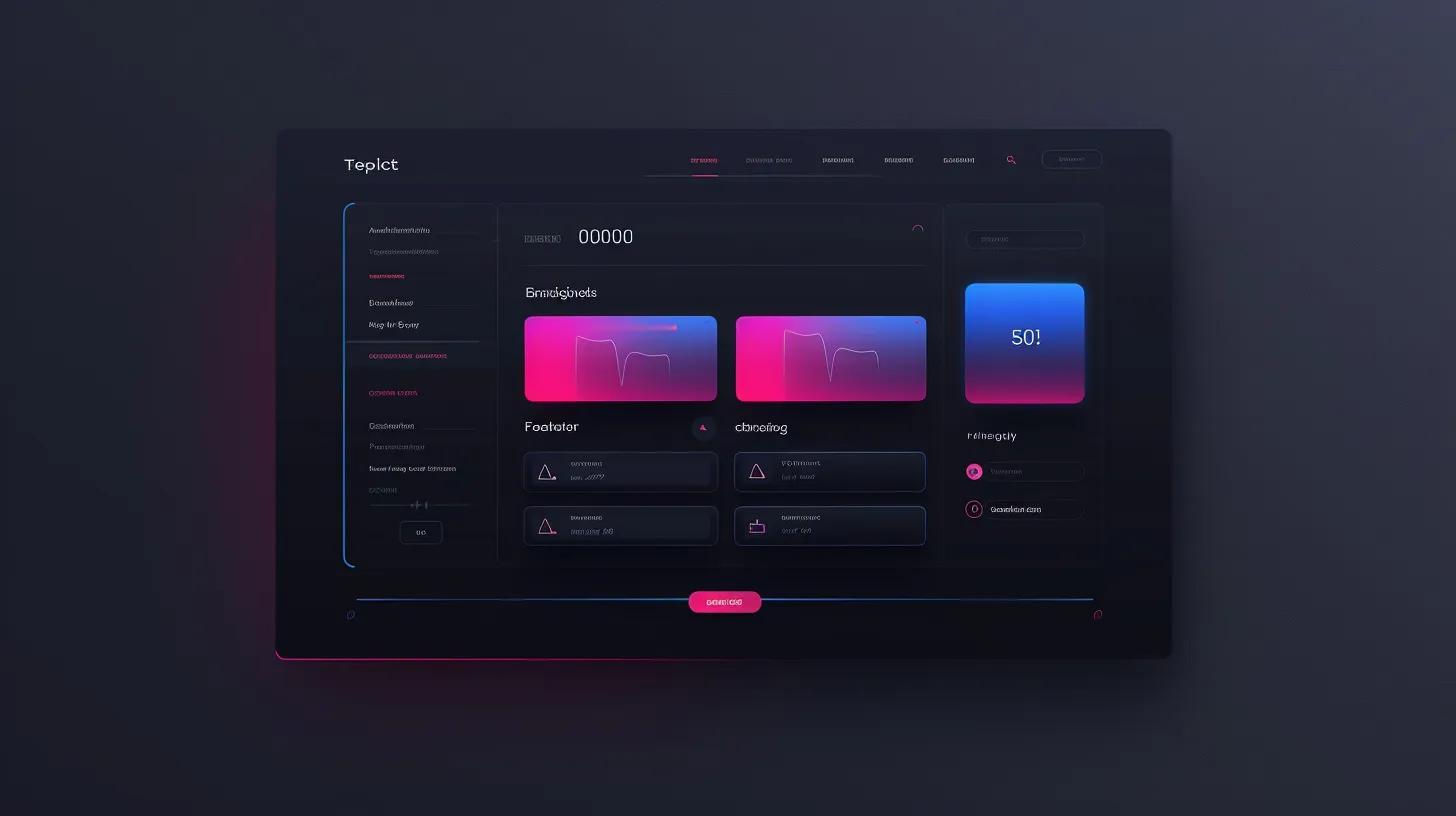Is your small business‘s website not performing as expected? This article will guide you through essential, affordable web design strategies that can transform your online presence. We’ll focus on creating a mobile-friendly interface and improving loading speeds, which are critical for user satisfaction. Additionally, we’ll delve into the importance of intuitive navigation and compelling calls to action, which are key to driving engagement. By implementing these bespoke web design tips and integrating a content management system for seamless updates, you’ll address the common pain point of a stagnant digital footprint. Engage with this content to enhance your business‘s online visibility and development, ensuring your website stands out in a crowded market.
Ensure Your Website Is Mobile-Friendly and Responsive

In today’s mobile-centric world, small businesses must prioritise mobile-friendly website development to ensure user satisfaction and SEO success. Selecting a responsive design template is the first step toward a versatile online presence. Optimising images and simplifying navigation menus are essential for quick mobile loading and ease of use. Adjusting font sizes enhances readability across devices, while thorough testing on various platforms guarantees consistent functionality. Finally, streamlining content is key to delivering a seamless mobile experience. These strategies are vital for engaging users and maintaining a competitive edge in website hosting and content delivery.
Choose a Responsive Design Template for Your Site
For small businesses seeking an affordable website solution, selecting a responsive design template is a strategic move that aligns with both user experience and SEO objectives. Platforms like WordPress offer a variety of templates that automatically adjust to the screen size of various devices, ensuring that your bespoke website design looks impeccable on desktops, tablets, and smartphones alike. Integrating Google Analytics into a responsive design allows for the monitoring of user interactions, providing valuable insights that can further refine the browsing experience. This approach not only caters to the needs of your audience but also positions your website for better performance in search engine rankings.
Optimise Images for Faster Mobile Loading Speeds
For small businesses aiming to enhance their online presence, optimizing images is a critical step in web hosting and WordPress web design. High-resolution images can slow down page loading times, particularly on mobile devices, which can frustrate users and negatively impact a company‘s marketing efforts. By compressing graphics and using appropriate file formats, businesses can significantly improve site speed without compromising on quality. This optimisation ensures that visitors enjoy a swift and smooth browsing experience, encouraging them to engage more deeply with the website’s content.
Simplify Navigation Menus for Easy Mobile Use
For small businesses, the creation of responsive websites that cater to mobile users is not just a trend but a necessity. Simplifying navigation menus is a critical aspect of affordable website design, ensuring that clients can easily find what they need without getting lost in a maze of pages. A streamlined menu enhances the user experience, facilitating efficient content management and interaction with the website on smaller screens. This approach not only meets the practical needs of users but also contributes to the overall success of the website in achieving business goals.
Adjust Font Sizes for Better Readability on Devices
When small businesses employ a website builder to create a responsive online platform, attention to detail such as adjusting font sizes becomes crucial for enhancing readability on various devices. A well-chosen font, with a size that remains legible on smartphones and tablets, can significantly reduce the cost of customer support inquiries related to readability issues. Moreover, incorporating the business‘s logo and email contact in a clear, visible manner ensures that these key elements are easily accessible, fostering better communication and a professional appearance across all devices.
Test Website Functionality on Various Mobile Platforms
Testing the functionality of a website across various mobile platforms is a critical step in the deployment of responsive web design. Small businesses must ensure their website design packages include comprehensive testing on different devices to confirm that information is displayed correctly and server interactions are smooth. This process identifies any device-specific issues, allowing for timely adjustments that result in a universally accessible and user-friendly website. Such diligence in testing underscores a commitment to quality and can significantly enhance the user experience, fostering trust and customer loyalty.
Streamline Content for a Seamless Mobile Experience
In the realm of small business success, streamlining content for a mobile experience is not merely about reducing quantity but about enhancing quality. A business‘s online platform should integrate seamlessly with social media, offer clear information on services and fees, and ensure that the domain name is memorable and relevant to the business. By focusing on concise, impactful content, small businesses can facilitate a smoother user journey, reducing bounce rates and fostering stronger engagement. This strategy is particularly effective in a mobile context, where screen real estate is at a premium and users expect quick access to information while on the internet.
Improve Website Loading Speed for User Satisfaction

For small businesses, optimising website loading speed is a critical factor in enhancing user experience and bolstering the effectiveness of web design services. This section delves into practical methods such as compressing images without losing quality, enabling browser caching, minimising HTTP requests, utilising content delivery networks, optimising code, and leveraging asynchronous loading for JavaScript files. These strategies, crucial for services web design and social media marketing, are designed to fit within a budget while maximising site performance and user satisfaction.
Compress Images Without Sacrificing Quality
For small businesses aiming to improve their website‘s usability, compressing images is a crucial step that should not compromise quality. A skilled web developer can utilise advanced compression techniques to reduce file sizes, ensuring that the visual appeal of animations and graphics on the landing page remains intact. This service not only accelerates loading times but also preserves the aesthetic value of the website, which is essential for attracting and retaining customers.
Enable Browser Caching to Reduce Load Times
Enabling browser caching is a pivotal strategy within web design packages that small businesses can employ to enhance their website‘s performance. When a user visits a website, elements such as logos, headers, and footers are stored in their browser, reducing the need to reload them upon subsequent visits. This technique not only accelerates page load times but also conserves bandwidth, offering a more efficient browsing experience that aligns with the brand‘s commitment to customer satisfaction.
Minimise HTTP Requests by Combining Files
In the realm of web design, small businesses can significantly enhance their online presence by minimising HTTP requests, a technique that streamlines the user interface. By combining files such as CSS and JavaScript, a website‘s software can reduce the number of server requests, leading to faster page loading times and a more fluid user experience. This optimisation is particularly effective for improving the performance of a website‘s online platform, ensuring that visitors can access content swiftly and without unnecessary delays.
Use a Content Delivery Network for Faster Delivery
Implementing a Content Delivery Network (CDN) is a strategic move for small businesses aiming to enhance their website‘s loading speed, which is a key factor in search engine rankings and customer satisfaction. A CDN stores a website‘s static assets on multiple servers across different locations, allowing for faster delivery of content to users based on their geographic proximity. This not only improves site speed but also reduces maintenance and advertising costs, as the distributed nature of a CDN can handle more traffic at a competitive price. By ensuring quick access to their website, businesses can keep customers engaged and reduce bounce rates, contributing to a stronger online presence.
Optimise Code by Removing Unnecessary Scripts
For small businesses seeking to enhance their online presence, optimising code by removing unnecessary scripts is a cost-effective strategy that can lead to significant improvements in website loading speed. This process involves analysing the website‘s design and functionality to identify and eliminate any superfluous code that may be hindering communication between the site and its visitors. By streamlining the backend of a cheap web design, businesses can ensure that their site runs more efficiently, providing a faster, more responsive experience for users and improving analytics data accuracy.
Leverage Asynchronous Loading for JavaScript Files
Small businesses can significantly boost their website‘s performance by implementing asynchronous loading for JavaScript files. This technique allows a webpage to render and become interactive while certain scripts are still loading in the background, rather than forcing users to wait for all elements to load sequentially. As a result, visitors experience quicker interactions with the site, which can lead to increased engagement and reduced bounce rates, thereby enhancing overall user satisfaction and contributing to the success of the business‘s online presence.
Create Clear and Intuitive Website Navigation

For small businesses, the creation of clear and intuitive website navigation is a cornerstone of successful online engagement. Limiting menu items to essential pages streamlines the user experience, while descriptive labels for navigation links provide clarity. The implementation of a search bar offers quick access to information, and breadcrumbs enhance user orientation. Consistency across pages and a hierarchical content organisation further simplify navigation, making it easier for users to find what they need swiftly and efficiently.
Limit Menu Items to Essential Pages Only
For small businesses, the key to crafting an effective website lies in the simplicity of navigation. By limiting the menu to only essential pages, companies streamline the user‘s journey, reducing confusion and enhancing the overall user experience. This focused approach not only aids in maintaining a clean and organized website but also improves the site’s search engine optimisation by concentrating on core services and information, making it easier for potential customers to find and interact with the business online.
Use Descriptive Labels for Navigation Links
For small businesses aiming to enhance their online presence, the use of descriptive labels for navigation links is a subtle yet powerful tool. Clear, concise labels guide users effortlessly to their desired content, improving the overall user experience and reducing frustration. This practice not only aids in retaining visitors but also contributes to search engine optimisation by clearly defining the site’s structure, making it easier for search engines to index and understand the website‘s content.
Implement a Search Bar for Quick Access
Integrating a search bar into a small business website significantly streamlines the user experience by providing swift access to information. This feature allows visitors to bypass the navigation menu and directly locate the services or products they seek, enhancing the site’s usability and customer satisfaction. The presence of a search bar is particularly beneficial for e-commerce platforms, where users expect to find specific items quickly, thus improving the likelihood of conversion and reinforcing the business‘s online efficiency.
Include Breadcrumbs to Aid User Orientation
Incorporating breadcrumbs into a website‘s design significantly enhances user orientation, allowing visitors to trace their path back to the homepage with ease. This navigational aid not only improves the user experience by providing a clear hierarchy of the site’s structure but also supports SEO by defining a clean, organised path for search engines to follow. Small businesses benefit from this feature as it encourages users to explore deeper into the site without losing their way, thereby increasing engagement and the potential for conversion.
Ensure Consistency in Navigation Across Pages
For small businesses, ensuring consistency in website navigation across all pages is fundamental to providing a user-friendly experience. Uniform navigation aids users in developing a mental map of the website, allowing for effortless movement between sections and reducing the likelihood of confusion or frustration. This consistency not only supports ease of use but also reinforces brand identity, as users come to recognise and feel comfortable with the site’s layout, thereby increasing the time they spend engaged with the content.
Organise Content Hierarchically for Clarity
For small businesses, the clarity of website content is paramount, and organising information hierarchically addresses this need effectively. A logical structure, where main topics are followed by subtopics and details, guides visitors through the site with ease, enhancing their understanding and retention of the information presented. This methodical arrangement not only improves the user experience but also bolsters SEO by clearly signaling to search engines the relative importance of website content, aiding in higher search rankings and increased online visibility.
Craft Compelling Calls to Action to Drive Engagement

For small businesses, the effectiveness of a website hinges on its ability to prompt action from visitors. Crafting compelling calls to action (CTAs) is a critical strategy for driving engagement and conversions. This involves using strong action verbs, positioning CTAs prominently on pages, and designing buttons that capture attention. Aligning CTAs with user intent and creating urgency with time-sensitive offers are also key tactics. Additionally, testing various CTAs can uncover the most effective approach for encouraging user interaction. Each of these elements plays a vital role in converting website visitors into customers.
Use Strong Action Verbs in Your Call to Action
For small businesses aiming to convert website visitors into customers, the use of strong action verbs in calls to action is essential. These powerful verbs, such as ‘discover’, ‘start’, ‘build’, or ‘join’, command attention and encourage immediate response, directly influencing engagement rates. A well-crafted call to action with a dynamic verb can make the difference between a passive observer and an active participant, thereby enhancing the effectiveness of the website‘s design in meeting business objectives.
Position Calls to Action Prominently on Pages
For small businesses to effectively convert website visitors into active customers, it is essential to position calls to action (CTAs) prominently on web pages. A strategically placed CTA, such as a vibrant button or a standout link, immediately draws the eye and prompts users to take the next step, whether it’s making a purchase, signing up for a newsletter, or contacting the business for more information. This visibility not only serves the practical purpose of guiding users but also enhances the potential for increased engagement and conversion rates, a critical aspect of online marketing success.
Design Buttons That Stand Out Visually
For small businesses, the visual appeal of call-to-action buttons plays a pivotal role in guiding user behaviour and increasing conversion rates. Designing buttons with contrasting colors, bold fonts, and a size that balances prominence with the overall design can capture user attention effectively. It’s essential that these buttons stand out without clashing with the website‘s aesthetic, providing a clear visual cue for users to take the desired action, such as ‘Buy Now’ or ‘Contact Us’, thereby streamlining the path to engagement and sales.
Align Call to Action With User Intent and Needs
Aligning calls to action with user intent and needs is a strategic approach that small businesses must adopt to enhance website engagement and conversion rates. When a call to action resonates with what the user is seeking, whether it’s more information, a special offer, or immediate purchase, it significantly increases the likelihood of a user taking the desired step. Small businesses can achieve this by analysing user behavior on their website, identifying patterns, and tailoring calls to action that address specific user interests and requirements, thereby creating a personalised and effective user journey.
Create Urgency With Time-Sensitive Offers
Introducing time-sensitive offers on a small business website can effectively create a sense of urgency that encourages customers to act swiftly. By highlighting limited-time discounts or exclusive deals that expire within a short window, businesses can tap into the natural human tendency to avoid missing out. This strategy not only drives immediate engagement but also accelerates the decision-making process, leading to an uptick in conversions and a boost in sales performance.
Test Different Calls to Action for Effectiveness
Testing various calls to action is a critical practice for small businesses to determine which phrases and designs yield the highest engagement and conversion rates. By experimenting with different verbiage, button colors, and placement on the page, a business can gather data on user behaviour and preferences. This empirical approach allows for informed adjustments that align with customer motivations, ultimately enhancing the effectiveness of the website‘s calls to action and contributing to the business‘s online success.
Enhance Visual Appeal With Quality Images and Media

For small businesses, the visual appeal of their website is a critical factor in attracting and retaining customers. Incorporating high-resolution images that align with the content can captivate visitors, while videos offer a dynamic way to present products or testimonials. A consistent color scheme reinforces brand identity, and the strategic use of white space can significantly improve readability. Additionally, optimising media files for quick loading times and ensuring images are equipped with descriptive alt text are essential for both user experience and search engine optimisation.
Incorporate High-Resolution Images Relevant to Content
For small businesses, the strategic use of high-resolution images that are directly relevant to the content can transform a website from functional to captivating. These crisp visuals serve not only to engage visitors but also to convey the professionalism and attention to detail that customers associate with quality service. When a website integrates images that reflect its offerings and brand identity, it not only enhances the aesthetic appeal but also supports search engine optimisation efforts, as relevant images can contribute to improved search rankings and user engagement.
Use Videos to Showcase Products or Testimonials
Integrating video content on a small business website can significantly elevate the user experience by providing an interactive showcase of products or services. Videos offer a dynamic platform for businesses to share customer testimonials, which can build trust and credibility with potential clients. This visual medium allows for a richer presentation than static images, enabling businesses to demonstrate product features or share compelling stories that resonate with viewers, ultimately fostering a deeper connection and encouraging conversions.
Apply Consistent Colour Schemes Reflecting Your Brand
Applying a consistent colour scheme that mirrors a small business‘s brand identity is a subtle yet powerful tool in website design. The strategic selection of colors not only strengthens brand recognition but also evokes the desired emotional response from visitors, guiding their perception of the company. When a business employs a harmonious palette throughout its website, it not only creates a visually appealing experience but also fosters a sense of reliability and professionalism that resonates with customers.
Utilise White Space to Improve Readability
Strategic use of white space, often referred to as negative space, is essential in website design for small businesses, as it significantly improves readability and user experience. By allowing content to breathe, white space helps to focus the visitor’s attention on the most important elements, reducing cognitive overload and guiding users through the site with ease. A well-designed website that employs white space effectively can lead to increased user engagement and a higher likelihood of converting visitors into customers.
Optimise Media Files for Quick Loading Times
Optimising media files is a crucial step for small businesses to enhance their website‘s visual appeal without compromising on loading times. By compressing images and videos, businesses can ensure that their website remains swift and responsive, providing a positive user experience that is likely to retain visitors. This practice not only improves site speed but also contributes to better search engine rankings, as search engines favour websites with faster loading times.
Ensure Images Have Descriptive Alt Text for SEO
For small businesses aiming to improve their website‘s search engine visibility, incorporating descriptive alt text for images is a crucial yet often overlooked detail. This practice not only aids visually impaired users in understanding the content of images but also allows search engines to better index and understand the site’s visual elements, contributing to improved SEO performance. By ensuring each image features alt text that accurately and succinctly describes its content, small businesses can enhance their online discoverability and attract a wider audience.
Implement SEO Strategies to Boost Online Visibility

For small businesses, implementing SEO strategies is a critical step towards enhancing online visibility and driving success. Researching keywords relevant to your industry lays the foundation for targeted content. Optimising meta descriptions and title tags, along with creating valuable content that attracts backlinks, are key tactics for improving search rankings. Proper use of header tags structures content effectively, while submitting a sitemap to search engines facilitates indexing. Monitoring SEO performance with analytics tools provides insights for ongoing optimization.
Research Keywords Relevant to Your Industry
For small businesses, the discovery and integration of industry-specific keywords into their website content is a fundamental SEO strategy that can significantly enhance online visibility. By conducting thorough research to identify terms and phrases that potential customers frequently use in search queries, businesses can tailor their website‘s language to match these searches. This alignment not only improves the site’s relevance in search engine results but also connects the business more effectively with its target audience, driving traffic and increasing the potential for conversion.
Optimise Meta Descriptions and Title Tags
Optimising meta descriptions and title tags is a pivotal step for small businesses to enhance their website‘s search engine visibility. A compelling title tag serves as a concise preview of a page’s content, influencing both click-through rates and search rankings, while a well-crafted meta description provides a brief summary that entices searchers to visit the site. By incorporating relevant keywords and crafting these elements to reflect the content‘s value, businesses can improve their online presence and attract more targeted traffic.
Create Valuable Content That Attracts Backlinks
For small businesses, the creation of content that is both informative and engaging is essential for attracting backlinks, a key element in enhancing online visibility. By producing articles, guides, or studies that offer unique insights or practical solutions, a business can become a respected source within its industry, prompting other websites to link back to its content. This not only drives traffic but also signals to search engines the value and authority of the website, contributing to higher search rankings and greater digital success.
Use Header Tags Appropriately to Structure Content
Appropriate use of header tags, such as H1, H2, and H3, is essential for structuring content on a small business website, as it aids in both readability and search engine optimisation. When a site employs header tags to break down content into digestible sections, it not only enhances user engagement by making information easy to scan but also allows search engines to better understand and rank the site’s pages. This strategic organisation of content, with clear and relevant headings, directly supports a business‘s online visibility and success.
Submit Sitemap to Search Engines for Indexing
Submitting a sitemap to search engines is a crucial step for small businesses to enhance their website‘s discoverability. This process allows search engines to index the website more efficiently, ensuring that all pages are found and potentially improving search rankings. By providing a clear roadmap of the site’s structure, small businesses can facilitate better visibility in search results, connecting with more potential customers and driving traffic to their online presence.
Monitor SEO Performance Using Analytics Tools
Monitoring SEO performance with analytics tools is essential for small businesses to understand the impact of their website design on search visibility. These tools provide insights into traffic sources, keyword rankings, and user behavior, enabling businesses to refine their SEO strategies for better results. By regularly analysing this data, a business can identify trends, adjust to changes in search algorithms, and optimise their website to meet the evolving needs of their audience, ultimately driving more targeted traffic and increasing online success.
Conclusion
For small businesses, a well-designed website is crucial for attracting and retaining customers, enhancing user experience, and improving online visibility. By implementing responsive design, optimising images, and streamlining navigation, businesses can ensure their site is accessible and engaging across all devices. Clear calls to action, compelling content, and strategic SEO practices are key to driving user engagement and conversions. Ultimately, these simple design tips can significantly boost a small business‘s digital presence and pave the way for its success in the competitive online marketplace.
Questions and Answers.
What are the pros and cons of budget web design?
When considering budget web design, there are several pros and cons to take into account. One of the main advantages of opting for a budget-friendly web design service is the cost-effectiveness it offers. Small businesses or individuals on a tight budget can benefit from having a professional-looking website without breaking the bank. Budget web design services often provide templates or pre-designed layouts that can be customised to suit the client’s needs, saving time and money on development.
However, there are also drawbacks to consider when choosing budget web design. One common con is the lack of originality and uniqueness in the design. Since budget services typically rely on templates, there is a risk that your website may not stand out from competitors who use similar designs. Additionally, limited customisation options may hinder the functionality and user experience of the site. Another downside is the level of support and maintenance offered by budget web design services, which may be minimal compared to higher-priced options.
In conclusion, while budget web design can be a cost-effective solution for those with limited resources, it is essential to weigh the pros and cons carefully before making a decision. By understanding the limitations of budget services and considering your specific needs and goals, you can make an informed choice that aligns with your budget and long-term objectives.
Are budget web design services limited in functionality?
Budget web design services can be a cost-effective solution for individuals and small businesses looking to establish an online presence without breaking the bank. While budget web design services may come at a lower price point, it does not necessarily mean that they are limited in functionality. Many budget web design services offer a range of features and capabilities to create a professional-looking website that meets the needs of their clients.
One potential limitation of budget web design services is the level of customisation and unique design options available. Because these services often use pre-made templates or basic design elements, clients may not have as much flexibility or creativity in the overall look and feel of their website. Additionally, budget web design services may have limitations in terms of advanced features or integrations that are typically found in more expensive custom-built websites.
Overall, while budget web design services may have some limitations in terms of design options and advanced functionalities, they can still provide a solid foundation for individuals and small businesses to establish an online presence. It is important for clients to carefully consider their specific needs and priorities when choosing a budget web design service to ensure that it aligns with their goals and budget constraints. By working closely with the web design team and clearly communicating expectations, clients can still achieve a professional and functional website within a budget-friendly framework.
How does budget web design impact search engine optimisation?
For businesses looking to establish a strong online presence, budget web design plays a critical role in influencing search engine optimization (SEO) outcomes. A well-designed website that is structurally sound, visually appealing, and user-friendly is more likely to rank higher on search engine results pages. A budget-friendly web design solution can ensure that essential SEO elements, such as meta tags, headings, image alt text, and responsive design, are implemented effectively to cater to search engine algorithms.
The impact of budget web design on SEO extends beyond basic website elements. Customisation options and strategic use of keywords within the website content can also enhance SEO performance. By investing in a budget-friendly web design that focuses on integrating relevant and high-ranking keywords, businesses can attract more organic traffic to their website. Additionally, a responsive and mobile-friendly design, which is often a feature of budget web design services, can further boost SEO rankings, as search engines prioritise mobile-friendly websites in their algorithms. In conclusion, choosing a budget web design service that prioritises SEO techniques and best practices can contribute significantly to a business’s online visibility and overall success in the digital landscape.
Do I need a website for my small business in Leeds?
As a professional content writer based in the United Kingdom, it is essential for small businesses in Leeds to have a website in today’s digital age. Having a website not only establishes credibility and trust with potential customers but also significantly expands the reach of your business beyond the local market. With the increasing trend of online searches and consumer behaviour shifting towards digital platforms, a website acts as a 24/7 digital storefront for your business, allowing potential customers to learn about your products or services at their convenience.
Moreover, a well-designed website can serve as a powerful marketing tool, enabling small businesses in Leeds to showcase their unique offerings, highlight customer testimonials, and provide valuable information about their brand. Additionally, a website can help in improving search engine visibility, making it easier for local customers to find your business online. By investing in a professional website, small businesses can stand out from competitors, attract new customers, and build long-lasting relationships with their target audience in Leeds and beyond. In conclusion, having a website is no longer just an option but a necessity for small businesses looking to thrive in today’s competitive market.
